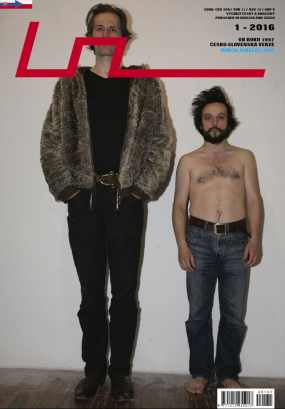| Umělec magazine 2016/1 >> Contents 2016/1 | List of all editions. | ||||||||||||
|
|||||||||||||
Contents 2016/1Umělec magazine 2016/104.10.2016 11:23 Divus | en cs |
|||||||||||||
|
Solutions Where can we go in search of empathy, where to find compassion for our fellow man? Borjana Dodova writes that the chance of renewing or reinforcing our bonds to all of humanity depends upon the vantage point from which we look at the world – whether from a skyscraper or from orbit. The experiences of those who have seen the Earth from space have inspired the author to consider whether we should launch into space those who have the power to change things.
Critique Who is Varlén and where did he come from? What does he look like, this man whose steps are muffled by piles of papers and discarded magazines at a waste recycling center? Where have all the people disappeared to, and whose laughter resounds from inside abandoned semiotic wrecks? This critique aims not to put you to sleep with piercingly poetic questions. This critique offers answers!
Interview
How can we take an adult man who sits on the subway eating crème eggs seriously, asks Beth Fox. Today’s generation of men-children represents a problem that we have not yet begun to deal with. The drawings of Mike O’Brien are perhaps a good introduction to their world. Italian sociologist and philosopher Lazzarato explores Nietzsche’s concept of debt from On the Genealogy of Morality. “Man,”, says the German philosopher, “is an animal that can make promises.”. Using excerpts from his book The Making of the Indebted Man, Lazzarato looks at what this definition of man means today in relation to the questions of credit, “doing business with oneself” or the so-called “economy of time.”
Architecture London’s jagged skyline reminded J. G. Ballard of an encephalograph of a mind in crisis. Bas Groes studies the famous British author’s use of the language of architecture as an expression of politics and social reality.
Architecture Rab Harling, a temporary resident of London’s famous architectural jewel, describes how art and artists are abused as part of a deceptive PR strategy. With “artwashing,” proclamations of cultivating and providing a space for poor artists are used to hide commercial interests, as was the case with Balfron Tower – where the building’s original social intentions was discarded and its original lower-class residents forced out.
Architecture A detailed description of artwashing at Balfron Tower. Seanie O’Shea describes how a private company colluded with the local council to use artists in order to force out long-term but “unprofitable” tenants in the name of gentrification.
Architecture For some, architect Ernö Goldfinger’s tower was their entire life; for others, it represents a period of want and a time of personal change.
Architecture The fate of the London high-rise in a poem by young performer, poet and singer Jemima Foxtrot.
Essay This unassuming but distinctive Jewish artist and writer was active in Paris during the interwar years. She associated with Bataille, Breton and Tzara, but was somehow overlooked among all these men. This excerpt from an essay by Roee Rosen explores the complicated relationship of members of the avant-garde with a woman as a silenced presupposition.
What remains Excerpts from the unapologetically Bataillesque writings of Justine Frank. Animality, nihilism, and physicality laid bare.
Short story It doesn’t matter whether Seymour Hersh is right or not: bin Laden is dead. But before he kicked the bucket, he managed to write a sci-fi story about the future of America – or rather, ’Mehrica,’ a travelogue through the vine-covered ruins of a fallen civilization. Find out what the Muslim travelers encounter in this forgotten land, in an abridged version of the story.
Comics Do you have a problem but don’t know what to do? Call the Somnambulance! It will help you find the meaning of life.
Art project In his paintings, Columbian artist Felipe Cortes Clopatofsky explores evolution in the islands of garbage floating in the open ocean. Or: what will the sketches of future biologists look like when they land on these islands like Darwin once did on the Galapagos?
Profile “Has anyone ever understood Stu Mead? Has Stu ever understood himself, when he often openly regrets the things he has said in media interviews?” asks our magazine’s publisher in a text from his new book on the art of this American eccentric.
Critique Things aren’t so simple when it comes to the masturbatory art of Stu Mead. Although it can be appreciated without further explanation, we will see much of it differently if we know a little about its creator. Czech artist Lenka Klodová, who frequently uses nudity in her art, looks at Mead’s work within the context of its physicality.
Literature Zinovy Zinik is a perceptive “face in the crowd” in London, a refugee from Moscow’s intellectual world of the 1980s and a Jerusalemite seeker of the paths of false prophets. His latest book is inspired by the true story of an artist obsessed with dead animals. In it, he develops the idea of a sound experiment that fatally spins out of control and reveals a historical conspiracy of pedophiles in the Artek children’s camp in Crimea.
Future
We conclude this issue with a text by Martin Kohout, who at the turn of 2015/2016 held an exhibition entitled Jokes Machines Make About Humans: 1st Infusion at Prague’s Polansky Gallery. Although the text was available to exhibition visitors in written form, it is above all a sound recording on which Roland Meijer Drees reads a letter in the voice of Sir David Attenborough. The text is reprinted from the General Fine Arts Journal (ed. Tom Clark).
04.10.2016 11:23
Recommended articles
|
|||||||||||||






Comments
Add new comment